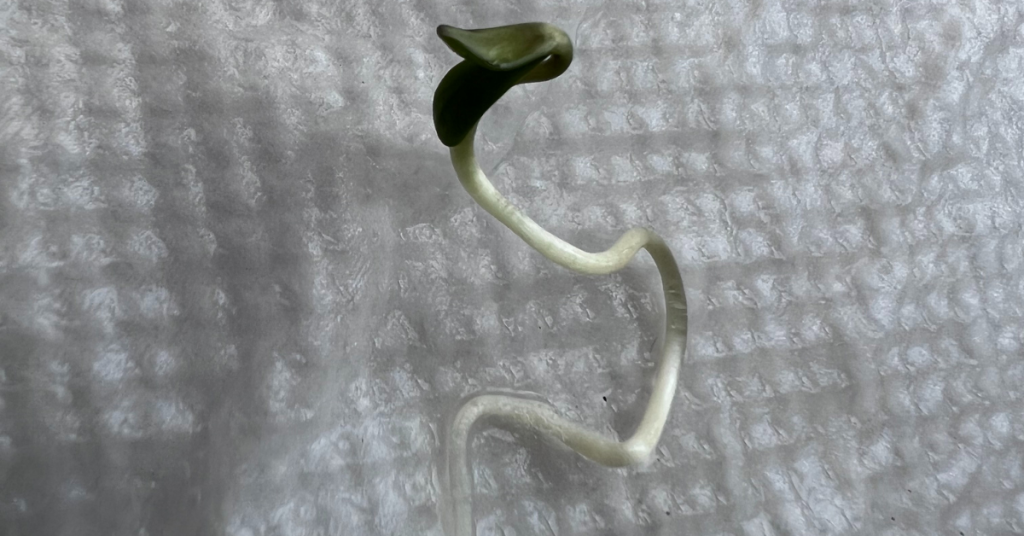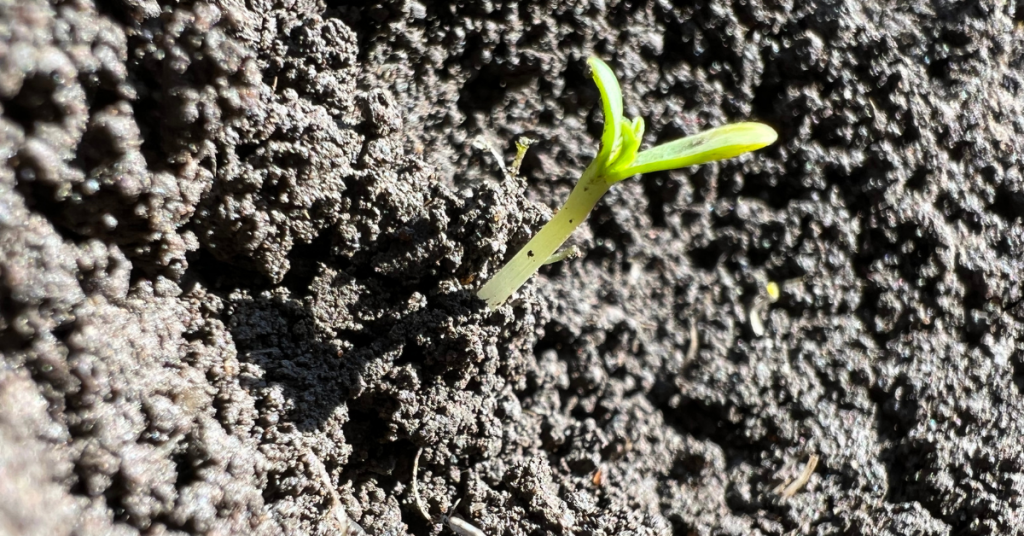Before you start growing marijuana, it’s essential to plan early; what I mean is; buy strains that suit your budget, growing experience, and equipment, so you have all you need at hand to use when the need arises. But well, what do you do when you have cannabis seedlings already germinated, and you are looking at them and wondering what do I do next?
Everything seems complicated until you place that first foot forward. Congratulations! You ordered cannabis seeds, and now you have them in your possession. Then what? You ask yourself.
Lucky for you, you have been keeping up with Marijuana Grow Hub, and you know what cannabis seeds are; how to differentiate the good ones from bad ones, and being the good student you are, you have germinated them.
First, don’t panic, you are already doing so well, and we are proud of you. Buckle up your seatbelt, and let’s guide you on everything there is to know about cannabis seedlings
What is the cannabis seedling stage?

After germinating, the cannabis seedling stage is the resulting stage of marijuana seeds. When you expose pot seeds to moisture and warmth, the inactive genetic composition in the seeds is activated, which triggers the taproot to pop out, breaking through the seed’s outer coating.
By the laws of nature, the taproot grows longer in the downward direction looking for water in the medium it’s growing as the seed bursts open, exposing the cotyledon from which true leaves develop, growing upwards in search for light.
What next after germination

Germinating cannabis seeds can be as simple as placing them in distilled lukewarm water in a warm environment, and you should see a taproot if your marijuana seeds are viable. Relatively straightforward, right?
But more than just that, you need to have the suitable medium and climatic conditions for the seedlings because when you get them wrong, the cannabis seedlings are bound to die since they are fragile.
And I know there is so much talk of people telling you that once cannabis seeds from resilient varieties like auto-flowers germinate, they can make it on their own. But unfortunately, that’s not so true, which explains why novice growers have difficulty keeping cannabis seedlings alive.
The growing medium
We will mainly focus on soil because most growers use it but will talk about other growing mediums in subsequent articles.
Light, well-aerated acidic soil with minimal nutrients is ideal. Nutrient-rich soils can be too much for the seedlings; however, you can start adding nutrients when the seedlings develop leaves.
Many growers have difficulty deciding if they should add water before placing the soil in the container or after, and this is what we have to say. When you add water to the soil before placing it in your container, it becomes compact, reducing the soil aeration and giving the seeds a hard time breaking through the soil.
We recommend you get a clean container, create holes in the bottom and sides, place well-aerated loose soil and add perlite to it to assist with soil aeration and nutrient retention. The soil eases water drainage and reduces the chances of water clogging when water is I excess.
Add water only when the soil is drying out, using a spray mist to regulate the amount of water so you don’t overdo it.
Which pots or containers can I use for my seedlings?

It comes down to the cannabis strains you choose to grow because some produce tiny plants with shallow roots that can survive in smaller pots, while others are bug plants with extensive root systems that require buckets that can accommodate them.
The market gives you extensive options of pots to use, so it’s your preference and wallet to guide you on which ones to buy.
Pots for auto-flowering cannabis seedlings
Auto-flowers have a short growth cycle, and they are prone to dying from shock from the stress, especially during transplanting, since they don’t have time to recover from it, so it’s wise to plant them directly in the final pots.
Pots for feminized cannabis seedlings
You should not have a problem transplanting feminized cannabis seedlings, significantly when they start outgrowing the starter pots and have a bunch of true healthy leaves because they are more stable and less prone to stress.
Light
With your marijuana seeds in the appropriate growth medium and pot size, you could be thinking the challenging phase is now done, but hey, you are just getting started.
You have a fragile stem with cotyledons and two true leaves! Strong HID or LED bulbs will burn the seedlings, and you will see crinkled leaves. With less light, the cannabis seedlings have no direction of growth, so they grow tall and collapse.
I am sure you’re now wondering, what do I do? First, grow the marijuana seedlings in the blue spectrum of CFL bulbs for approximately two weeks until you see more leaves and nodes; then, you can increase the lighting because your plants are now in the vegetative stage, and they need all the light they can get.
Temperature
The appropriate lights usually ensure the right temperature in an ideal growing environment but to break it down, keep the temperatures at 20-260C for daytime and 4-60c for darkness.
When the leaves start drying with curls on the edges, then the temperatures are high, leading to stunted growth.
Slow growth, wilting, and weak stems are signs of low temperatures because the cells are not active in transporting nutrients and water or using oxygen, leading to stunted growth and death as days pass.
Humidity.
Let’s simplify it like this; the cannabis seedlings don’t have a well-developed root system to absorb water at this stage of growth fully, so the leaves help out through osmosis. However, high humidity levels of over 60% mean most of the water in the vapor in the atmosphere is clogging in the leaves since they are not yet well built to absorb most of it, exposing them to fungi and pests. On the other hand, less humidity means malnutrition to the plants due to nutrient deficiencies, so the solution keeps humidity to approximately 50%.
Growing cannabis seedlings outdoors
Raising cannabis seedlings outdoors means leaving them to the climatic conditions mother nature offers, so you should ensure the frost is over and the sun is reliable.
How to water cannabis seedlings
I know it sounds obvious, and your mind is telling you, relatively simple, get water and add to the seedlings; what’s the big deal? Well, you can end up underwatering or overwatering, and both extremes come with consequences.
Overwatering marijuana seedlings
Like you pace yourself and don’t drink all the water your body needs at once, so should it be with your plants. I think watering excites many beginners because they don’t want their plants to dry out; they end up overdoing it, which is bad for the plants. Also, because you are drowning the tiny roots, thus depriving them of oxygen, so the plants cant breathe.
Overwatering also activates dormant fungi like Fusarium and Pythium in the soil that attack and dry your plant in less than 24 hours, a condition we call damping off, which shows the signs when it’s too late you cant save the plants.
To prevent damping, sterilize old soil or use new soil and use drained pots.
Underwatering cannabis seedlings
So you are wondering? Should I underwater the plants then? The answer is no because transpiration and heat cause the plants to lose water, so they need water in the soil to absorb the necessary nutrients for growth.
In both cases, you see the leaves wilting and drooping.
The moral of the story; is don’t overdo it, and we advise you use a mist spray because it regulates the amount of water and grows the seeds in the right pot size, so you are not tempted to overwater because the pot is enormous and the reverse is true.
My cannabis seedlings are growing abnormally long with thin stalks.
Ohhh, it’s a condition known as seedling stretching. It mostly happens when you keep seedlings in the dark for long, so technically, they stretch looking for light.
The solution is to use low-intensity light not very far above the seedlings.
Cannabis seedling nutrition
The early stages of seedling don’t require nutrients because they can stress the plant and stunt growth. Instead, healthy organic pest and pathogen-free soil are suitable.
As plants grow, they start communicating their needs in what their leaves look like, and if you monitor closely, you can identify and rectify the condition in time.
So when do I start feeding the seedlings with nutrients, you may ask? 3-4 weeks after germination because they are ready for the vegetative stage.
When you transplant the plants, you should first monitor them to ensure they adjust to their new environment before feeding them to avoid double stressing the plant.
4:2:3 of NPK is a good start ratio as they start vegetating.
Cannabis seedlings experience nutrient burn when you feed them too early or with very strong fertilizers, and you notice dark green leaves with burnt tips, and the leaves curl upwards as the condition worsens.
If you notice this, stop feeding them and water with neutral pH water till the plants return to normal and you can resume with the nutrients.
How to keep pests and diseases at bay
Cannabis seedlings are fragile, and an infestation can kill the plants in less than a day. As we have been giving hints, keep a clean well-aerated environment and optimize the temperature and humidity.
Don’t overwater the plants; that doesn’t mean underwater them either; get a balance.
Cannabis seedling transplant.
Transplanting is the final stage of cannabis seedling because, at this point, it is preparing to enter the vegetative stage, and this is approximately 3-4 weeks after germination.
There is no specific age for transplanting seedlings because some strains grow faster than others, but when you observe them, the answer is always in your plants. They can tell you when they are ready.
In the case of starter boxes, you can cut them open and transplant the seedling with its initial soil into the final growing medium. Create a hole in the growing medium that can accommodate the soil and roots; this reduces stress on the plants due to less interference with the roots.
Identify the health of your cannabis seedlings by color.
Less and too much of everything is not good, so a medium green of the marijuana leaves is fine.
However, deep green is a sign of excessive nitrogen.
Reddish and purple colors are usually genetic-based though they can imply lower temperatures.
Yellow is an alarm color though there are exceptions
The yellow of the cotyledon immediately after germination when the seedlings die-off
The other yellow is in the middle of the leaves very early in the morning, and if you observe them closely, they turn green as more chlorophyll is produced.
Part yourself on the back
You have come this far, and we are super proud of you.
With the fragile, complex part out of the way, nothing can stop you now. With the appropriate water, nutrients, lighting, temperature, and humidity levels, the sky is the limit for you.
Keep up with Marijuana Grow Hub for more growing tips. Thank you.
